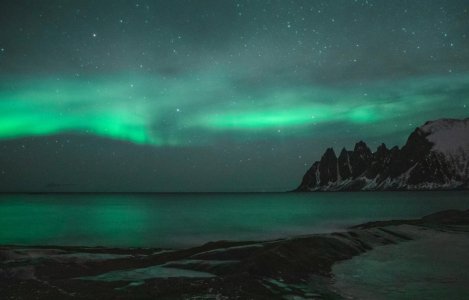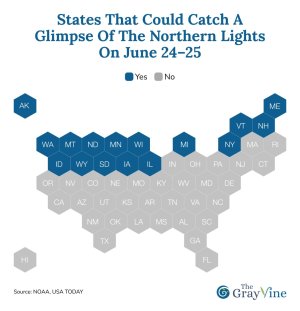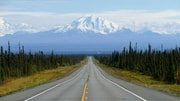Could the northern lights appear in your state this week? Here’s when and where to look
By
Veronica E.
- Replies 0
If you've ever dreamed of catching a glimpse of the northern lights, this week might be your best shot—no passport or Arctic expedition required.
Thanks to increased solar activity, parts of the US may get a rare chance to witness this dazzling natural display right from their own backyard.
While the aurora borealis is typically reserved for far northern latitudes, strong solar storms can sometimes push the spectacle farther south.
NOAA’s latest forecast suggests the conditions could be just right on June 24 and 25.
Here’s where to look, when to go outside, and how to make the most of this midweek celestial show.

What causes the northern lights?
The aurora borealis is a natural light show caused by charged particles from the sun colliding with gases in Earth’s upper atmosphere.
These collisions release energy in the form of visible light, often in waves or curtains of green, pink, purple, and even red.
The lights are most commonly seen in places near the North Pole, like Alaska, Canada, and parts of Scandinavia.
But when solar activity is strong, the phenomenon can extend farther south, including into parts of the continental US.
Also read: Is it a bird…or a plane? What’s that in the sky? Bizarre aerial sighting stirs buzz
Where might they be visible?
Alaska will always have front-row seats, but forecasts show that several states along the northern border could catch a glimpse of the aurora. These include:
Depending on how the solar storm develops, the lights may dip even further south. NOAA’s forecast map uses color-coded bands to indicate how likely it is you’ll see the aurora.
Red means high probability. Green means there’s a chance you’ll see the glow on the northern horizon if the skies are clear and you're far from light pollution.

Also read: Celestial spectacle: Why the night sky turns red this week–Don’t miss it!
When should you look?
The best time to see the northern lights is usually between 10 p.m. and 2 a.m. local time. Tuesday and Wednesday nights (June 24 and 25) offer the strongest window of opportunity, assuming the skies cooperate.
If you're planning to watch, try to head somewhere dark and open, away from city lights.
Viewing tips for aurora chasers
Also read: Inside the $30k first class suite: Is it really just a fancy studio apartment in the sky? Find out here!
Why now?
We’re currently approaching a solar maximum, a peak in the sun’s 11-year activity cycle.
During this period, solar flares and geomagnetic storms are more frequent, which can increase the chances of auroras appearing at lower latitudes.
Past sightings in the US
The northern lights have made some memorable appearances in American skies before. In 1859, the Carrington Event brought auroras as far south as Cuba.
More recently, solar storms in 2003 and 2023 allowed sightings in states like Colorado, Illinois, and even Oklahoma.
While this week's display may not be quite as dramatic, it's still a rare treat.
Whether you’re planning a late-night skywatch or just curious about the science behind the spectacle, this week offers a rare opportunity to witness the northern lights without traveling far.
Clear skies, a bit of patience, and a good view of the northern horizon might be all you need!
Read next: Why people are still painting porch ceilings blue—and the reason might surprise you

Have you seen the northern lights before? Are you hoping to catch them this week? We’d love to hear your tips, stories, and photos. Let us know where you’re watching from—and if you're lucky enough to snap a great picture, share it in the comments!
Thanks to increased solar activity, parts of the US may get a rare chance to witness this dazzling natural display right from their own backyard.
While the aurora borealis is typically reserved for far northern latitudes, strong solar storms can sometimes push the spectacle farther south.
NOAA’s latest forecast suggests the conditions could be just right on June 24 and 25.
Here’s where to look, when to go outside, and how to make the most of this midweek celestial show.

A rare northern lights display could soon be visible in parts of the US, lighting up the night sky with vibrant color. Image Source: Pexels / Tobias Bjørkli.
What causes the northern lights?
The aurora borealis is a natural light show caused by charged particles from the sun colliding with gases in Earth’s upper atmosphere.
These collisions release energy in the form of visible light, often in waves or curtains of green, pink, purple, and even red.
The lights are most commonly seen in places near the North Pole, like Alaska, Canada, and parts of Scandinavia.
But when solar activity is strong, the phenomenon can extend farther south, including into parts of the continental US.
Also read: Is it a bird…or a plane? What’s that in the sky? Bizarre aerial sighting stirs buzz
Where might they be visible?
Alaska will always have front-row seats, but forecasts show that several states along the northern border could catch a glimpse of the aurora. These include:
- Idaho
- Washington
- Montana
- North Dakota
- Minnesota
- Wisconsin
Depending on how the solar storm develops, the lights may dip even further south. NOAA’s forecast map uses color-coded bands to indicate how likely it is you’ll see the aurora.
Red means high probability. Green means there’s a chance you’ll see the glow on the northern horizon if the skies are clear and you're far from light pollution.

NOAA’s forecast map shows where the northern lights may be visible on June 24 and 25, with the best chances in northern US states. Image Source: NOAA / USA TODAY.
Also read: Celestial spectacle: Why the night sky turns red this week–Don’t miss it!
When should you look?
The best time to see the northern lights is usually between 10 p.m. and 2 a.m. local time. Tuesday and Wednesday nights (June 24 and 25) offer the strongest window of opportunity, assuming the skies cooperate.
If you're planning to watch, try to head somewhere dark and open, away from city lights.
Viewing tips for aurora chasers
- Go dark: Find a spot with little to no light pollution—national parks, nature preserves, and rural areas are best.
- Look north: The lights will likely be low on the northern horizon.
- Keep an eye on the weather: Cloudy skies will block your view, so check your local forecast.
- Be patient: The aurora can flare up suddenly or slowly build throughout the night.
- Use a camera: A long exposure on your phone or DSLR might pick up colors that your eyes miss.
Also read: Inside the $30k first class suite: Is it really just a fancy studio apartment in the sky? Find out here!
Why now?
We’re currently approaching a solar maximum, a peak in the sun’s 11-year activity cycle.
During this period, solar flares and geomagnetic storms are more frequent, which can increase the chances of auroras appearing at lower latitudes.
Past sightings in the US
The northern lights have made some memorable appearances in American skies before. In 1859, the Carrington Event brought auroras as far south as Cuba.
More recently, solar storms in 2003 and 2023 allowed sightings in states like Colorado, Illinois, and even Oklahoma.
While this week's display may not be quite as dramatic, it's still a rare treat.
Whether you’re planning a late-night skywatch or just curious about the science behind the spectacle, this week offers a rare opportunity to witness the northern lights without traveling far.
Clear skies, a bit of patience, and a good view of the northern horizon might be all you need!
Read next: Why people are still painting porch ceilings blue—and the reason might surprise you
Key Takeaways
- NOAA forecasts suggest the northern lights could be visible in parts of the US on June 24 and 25, especially in states along the Canadian border.
- States with higher visibility chances include Idaho, Washington, Montana, North Dakota, Minnesota, and Wisconsin.
- Peak viewing hours are between 10 p.m. and 2 a.m. local time. Dark, rural areas offer the best chance to see the aurora.
- Solar activity is increasing as we near a solar maximum, making these southern sightings more likely.
Have you seen the northern lights before? Are you hoping to catch them this week? We’d love to hear your tips, stories, and photos. Let us know where you’re watching from—and if you're lucky enough to snap a great picture, share it in the comments!






